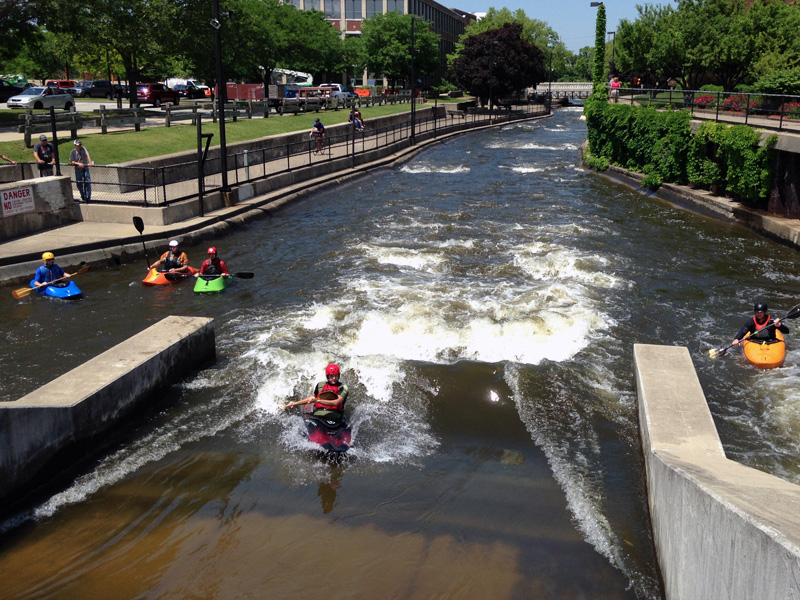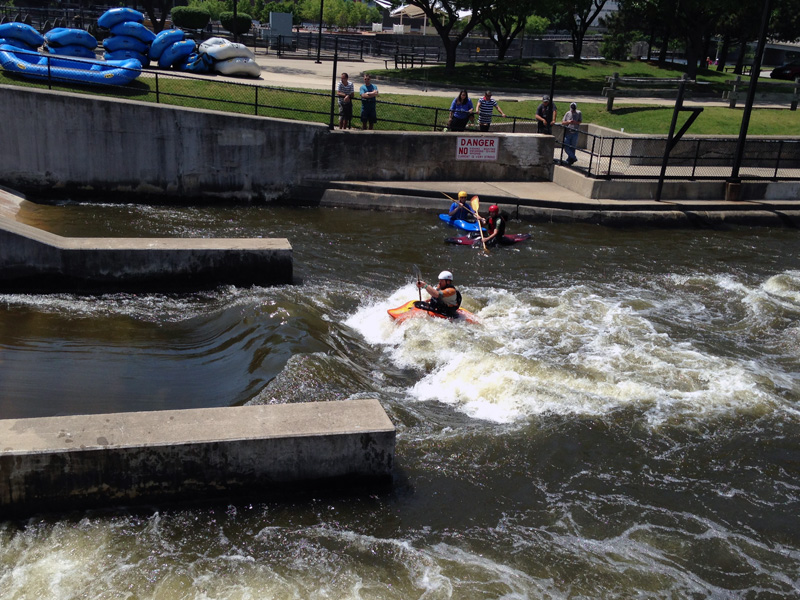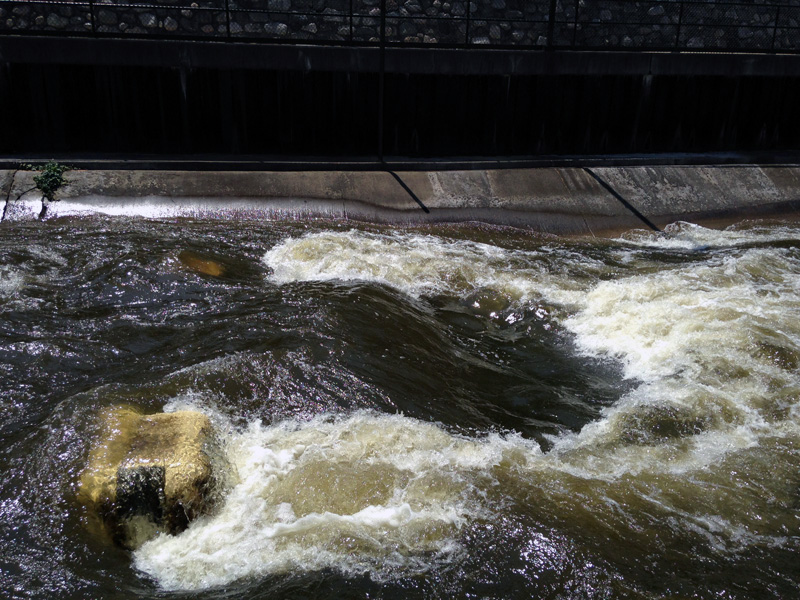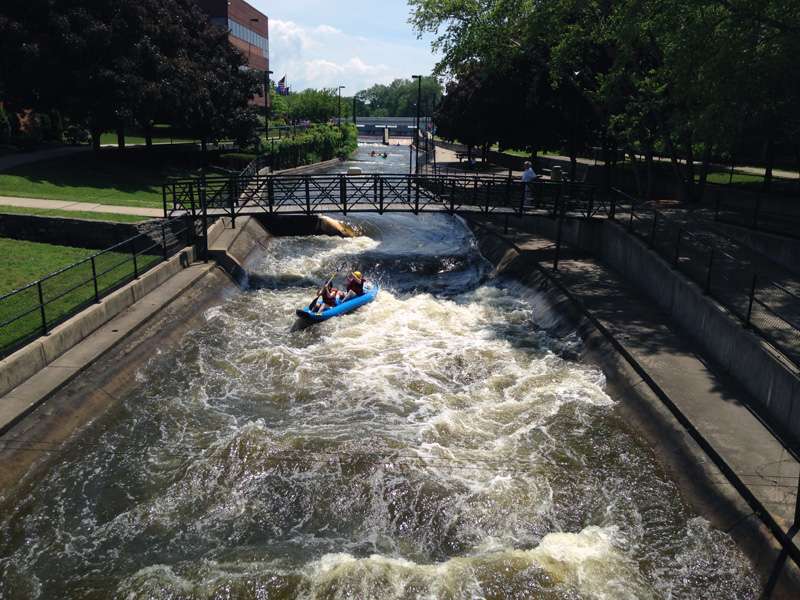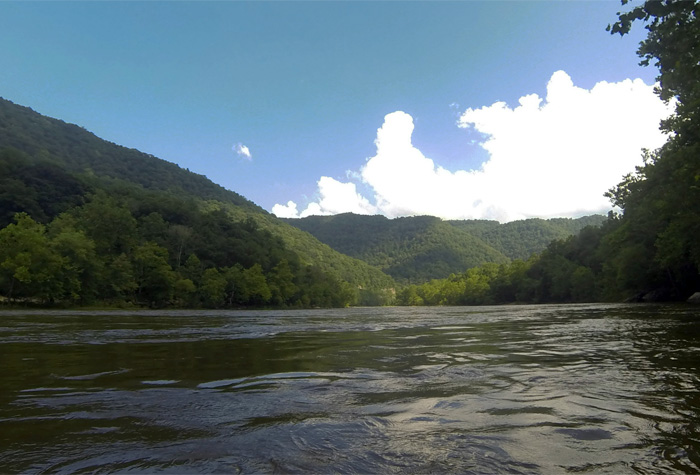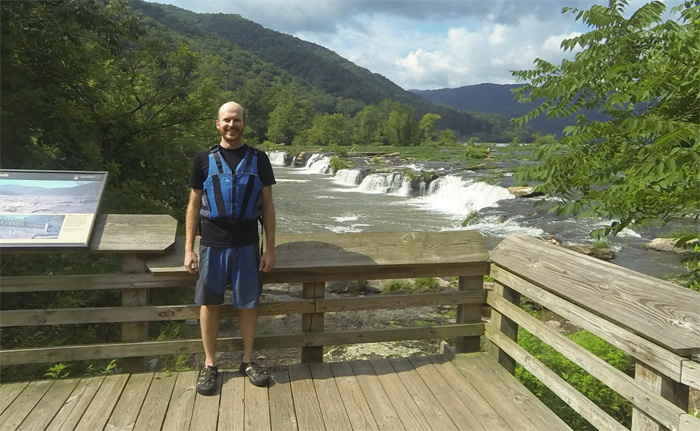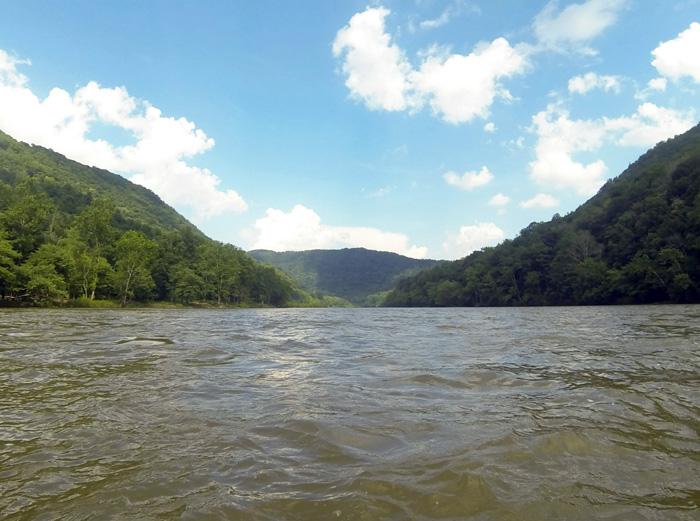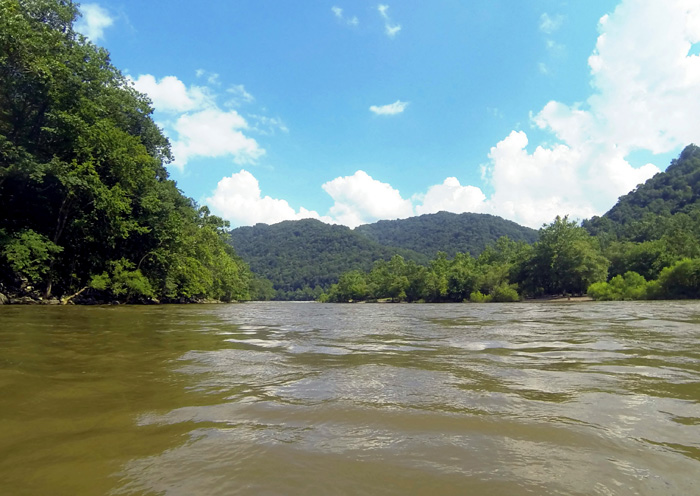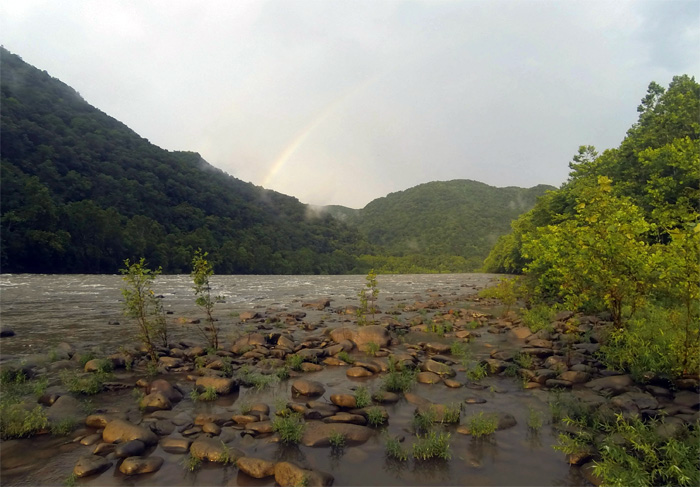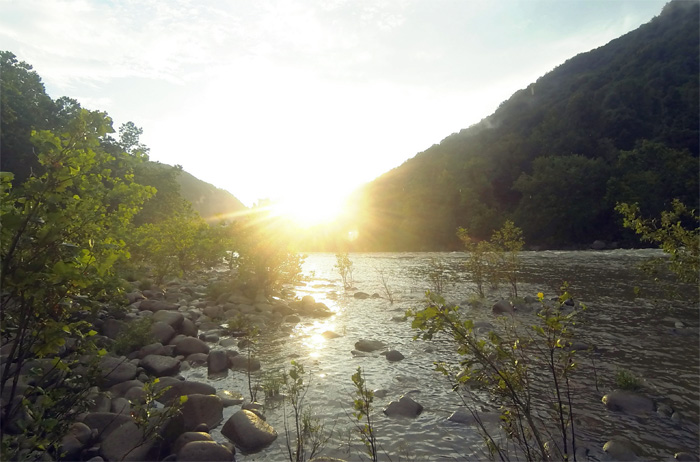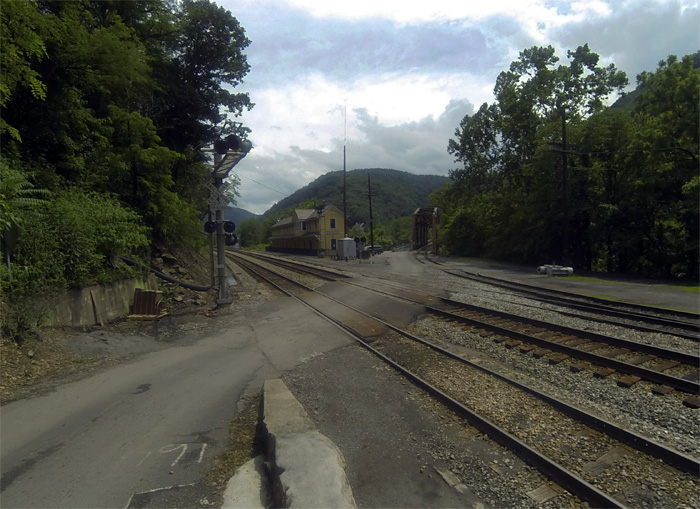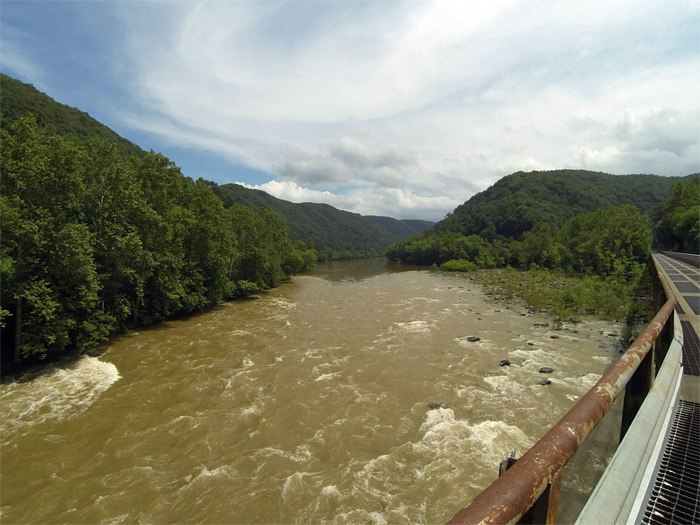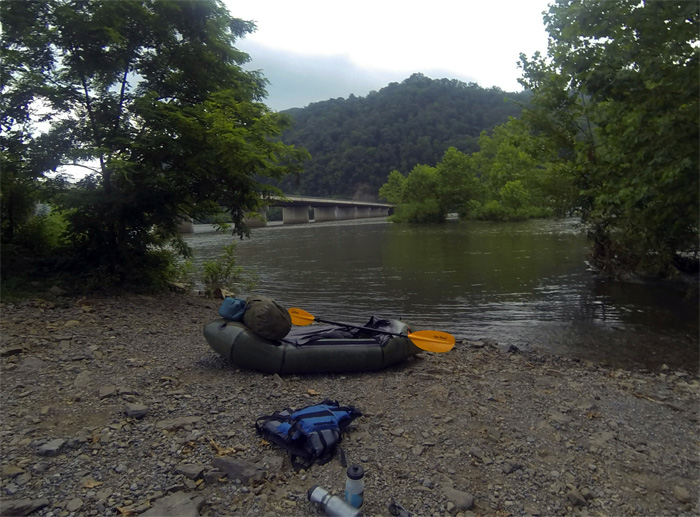Packrafting the East Race Waterway
Packrafting the East Race Waterway
My rafting trip in West Virginia last summer was one of my most ambitious to date, and was easily one of my most rewarding. It was the first time I had ever been in whitewater, and I realized pretty quickly that it is an unbelievable rush to hit a wild run of rapids. Since then, I’ve been scoping out other rivers closer to home, hoping to find something worth checking out. Unfortunately, the Midwest doesn’t have very many, save a few Class II-III rivers in central and southern Illinois, northern Wisconsin, and Upper Peninsula, Michigan.
But nothing around Chicago. And even though it’s still great to get out to a suburban river with my packraft, most of the flatwater rivers here are boring at best. So I left the city a few weeks ago on a train to paddle the East Race Waterway, an artificial whitewater run in South Bend, Indiana. It turned out to be a fine exception in an otherwise uneventful area for water sports.
Originally a $5 million project, the waterway was a two year undertaking that the city finally opened to the public in 1984. Since then, it has drawn approximately 270,000 visitors, many of whom were probably Midwestern paddlers like myself, who were looking for a quick and easy whitewater fix. It flows swiftly at 500cfs and a knot speed of 10 to 15 down a flat concrete channel for just short of a half mile through downtown. It is rated at Whitewater Class I-II, although I thought some of the bigger holes were borderline III. But with there being virtually no hazards in the river at all, and the fact that trained whitewater rescuers wait by the bigger spots with throw ropes, you would have to actually try to get hurt. Essentially, it is a skate park for whitewater rafting.
They offer rafting rides for $5 per person per run. Or if you have your own kayak, you can pay $15 for the day. I brought my packraft with me on the train, walked to the river, and spent two afternoons riding down the channel.
I was surprised at how swiftly it went, and how big some of the holes were. A lot of kayakers were out surfing the playwaves, but my raft can’t really do that, so I just hit the hydraulics head on. With enough brunt force, I could usually slam right through them. At the end of the run, I paddled through a wave train and past a big eddy to the take-out, carried my raft upstream, and got back in.
A lot of people asked me about my packraft, since they aren’t commonly used in the Midwest. Yes, it is indeed a badass wilderness boat that fits into a backpack, it is made of a high quality, durable, lightweight polyurethane, it kicks ass in whitewater, and yes, I can take it anywhere walkable without having to coordinate a shuttle ride.
I was asked almost every time without fail if I can roll the thing. My usual answer to that question is sort of. There isn’t enough leverage with the raft alone to respond to the hip snap needed to roll a capsized boat. I would have to mod the thing with thigh straps, which I hear also improves its maneuverability in technical runs. Other packrafters have been able to roll very effectively using this approach. For now, I just wet-exit like I did in the video and jump back in.
I absolutely recommend this waterway to anybody who is as sick of flatwater as I am. Especially if you’re a beginner and need a safe place to practice in moving currents. Even if you’re not into serious paddling, you can pay $5 to borrow one of the bigger, more stable rafts and float down with a few other people. The waterway is open every weekend afternoon through August.
Packrafting the New River Gorge Part 2: The Gorge
I woke up an hour past daybreak on Saturday morning, and got my first look at the river from the campground. It was one of the calmest places I had seen yet. The river, though a thousand feet wide, didn’t make a sound. It was violent and chaotic when it wanted to be, and in other places, though always powerful, was entirely serene, beautiful and calm, flowing quietly under a canopy of morning fog.
I was back in the water an hour later, just as the fog started breaking on the mountaintops. I made distance over a long pool as sunlight came over the mountains and breaking clouds, lighting up the river and western slopes of the valley. I approached Brooks Falls, the first big Class III rapid on the Upper River. I hung by the left bank as each wave got bigger than the last. My cargo-heavy bow seemed to crash through every one of them. Suddenly, I saw a huge four foot drop off up ahead. At the high levels, the boulders were submerged completely in a crashing pour-over, which dropped a few feet and crested into another big wave ten feet down. And I was heading right for it!
I had no time to dodge it, so I balanced and braced myself for the drop. I went over the edge, got spun around and thrashed backwards on the next big wave, and leveled out into calm water a few seconds later. I paddled on, cheering and screaming my head off. THAT’S WHAT I’M FUCKING TALKING ABOUT!!!! BRING IT BABY!!! BRING ON THAT SHIT!!!
The water was calm again. But man, was I ever in a good mood. I passed a choppy section by Brooks Island without much trouble. I found out from a local later that a huge eagle’s nest sat right at the northern tip of the island. I went right by it and didn’t notice. After more calm, uninterrupted distance, mist rose from the river ahead and the faint roar of Sandstone Falls echoed across the valley. I paddled along the western shore, looking for a portage takeout. I found it, drug my raft up the road, and carried my 30lb dry bag on my shoulders for a quarter mile, dragging the raft behind me. It was exhausting, but I finally got to the observation deck and put all that shit down so I could go see the waterfalls.
The entire river runs over 20 foot drops at Sandstone Falls, and at its base, wooden walkways and trails lead to the lookouts. I made a quick run around the trail system to get some pictures, and then carried my gear downstream to the next launch point.
A few miles downstream, I passed under I-64, which rumbled overhead, sitting on huge columns of concrete. Summer rainclouds passed above, which would no doubt build into thunderheads in a few hours. But at that moment, they brought a warm, pleasant shower on the river. For the rest of the afternoon, I went from big rapids to calm pools to big rapids, most of which were pretty easy. The weather could not have been better. A nice, sunny day in mid 80’s with a number of cumulus clouds floating along, casting shadows on the slopes of the ravine.
On the longest stretch of calm water, I passed the Hamlet Bridge Piers, four large concrete pillars that once supported a lumber railroad to a boomtown nearby. As I floated along, they passed serenely by my raft, reminding me of the scene in Lord of the Rings when the Fellowship rowed their elven boats past the Argonath statues.
Eventually, I passed the town of Prince and the Army Campground, where I had originally planned on staying that night. But I decided to keep going. It was good day, I was back on schedule, and had four hours of daylight to make even more distance. The river bended eastward after the Army Camp takeout, and after hitting a hard rapid and leveling out at the next pool, some kayakers caught up with me. They got started at Glade Creek, some ten miles back, and planned to take out at Fayette Station, a wild section of the Lower River.
Up ahead, the roar of Ledges Rapids faded into earshot as the crests of the waves jumped above the water line. It was another Class III. I paddled to the right to avoid some big waves and caught a good 100 feet of calm water. Down below by 20 yards ahead was a large boulder. I was heading right for it. I turned to the left to get out of the way and a 4 foot wave flipped my boat completely over.
FUCK!!!!!! I scrambled out from underneath, swallowed a mouthful of river water, and reached for the bow line on my raft. It slipped out of my fingers and the raft floated upside down ten feet ahead of me. SHIT!!! SHIT!!! SHIT!!!
Kicking wildly with my paddle in my right hand and waves crashing all around me, I absolutely had to catch that thing. I tried to pull it back with the paddle and had no luck. After a good, persistent minute of chasing, I got my hand on the bowline at last. I flipped the boat over, put the paddle on the far end, and lunged forward. No luck! It flipped again, sending me back into the water.
The rapids started to calm down. I thought maybe I could wait it out until the next calm section. No chance, up ahead was another run of rapids. I had two minutes to get back in or risk getting my feet beat up by the rocks. I flipped the boat back over, put the paddle on the far end, lunged as hard as I could, and made it, sprawling me across the raft, scrambled into position, ferried to shore, stumbled onto solid ground, and completely lost it.
The late afternoon sun hung above the western ridges. Big, lazy white clouds floated by. The river moved on. And in a quiet and lovely grove by the shore, I paced around trying to process what the fuck had just happened. What had just happened, I thought. I had been kicking this river’s ass up until now. And one wrong turn was all it took for me to go flailing into the water. Needless to say, my morale took a dive along with me. But by some stroke of pure luck, I recovered, losing nothing except a water bottle.
Eventually I calmed down. I went back to my raft to check on my cargo. Everything was intact. The dry bags were strapped securely on the bow, and my gear didn’t get a single drop of water. Somewhere in there, my electronics were ticking away like nothing happened. I rested for a few minutes and looked out at the river again. It was at the end of the rapids, and I still had a couple hours of daylight left. I wanted so badly to call it a day and set up camp, but knew I needed to keep going. Yes, my boat could capsize again, yes, it could be worse, but it could also be just fine. I got over bigger waves than that one without any trouble, just keep the bow pointed straight and I’ll be fine. I got back in and kept going.
It was calm again, giving me time to rebuild my confidence level. By the time I came around the next bend towards Silo Rapids, I felt better. I knew that if I had to, I would turn right towards those waves and hit those fuckers head on. Turns out I didn’t have to. I glided over some choppy shallows by the western bank and got chased to shore by an oncoming thunder cloud.
It’s almost impossible to tell when that will happen in that gorge. You can’t see the rainclouds until they’re almost on you. I pulled my raft up to a sandbar, said hello to a Boy Scout troop that was on a trip of their own, and got chased under my raft by a downpour not even ten minutes later. The storm seemed to last forever. I leaned my raft on a tree and sat underneath for at least an hour, disappointed that I missed my window to set up camp and had to wait out the downpour. Then all at once, it cleared up as quickly as it started.
I walked out to the river’s edge. To the west, a golden sunset broke through the clouds, and to the east, a rainbow stood high above the ravine. The storm clouds rumbled off into the night, the muggy landscape darkened, and I found a flat area in the woods to set up camp. I was four miles south of Thurmond. Good enough.
I slept in the next morning, seeing as I didn’t have to catch the Thurmond train until 6:00pm that day. Another dark cloud came over the gorge by surprise, rushing me to pack up before the next downpour. I had had enough of the river by then, so I packed everything up and started hiking northward on the sandbar right as the rain started. I reached a rocky outcropping, forcing me uphill. I pushed through some thickets and came out on the Stone Cliff Trail, which parallels the river to the Stone Cliff Bridge a few miles ahead. From there, I followed the road all the way to Thurmond.
Formerly a thriving coal mining town, Thurmond is now mostly abandoned, and has since become a tourist attraction on the river. With fewer than a dozen people still living there, the railroad depot was bought and renovated into a visitor center for the National Park Service. They staff the building with a park ranger, and have different exhibits on display of the history of the town and river.
I got there at noon, and spent the afternoon relaxing around the town and chatting with the ranger, a charming lady in her forties. She left around 5:00, and I waited for my train. An older man and his wife showed up at the station, where their son was planning to arrive. As it turned out, the older fellow was one of the original guides on the Lower River, which started gaining popularity in the whitewater community in the 70’s. Though at the time, the rafts weren’t nearly as developed, as durable, or as safe as now. It took some time, he said, for people to catch on.
I asked him how many fatalities happen a year out there. “The New River gets about one or so every year, but the Gauley is worse. That one gets about three.” One death a year isn’t bad, I thought, considering a lot of factors.
The train finally came. I stepped out the gorge and into an air conditioned train car. Minutes later I was sitting in the dining car, enjoying a hot meal and a cold glass of whiskey.
The New River is huge, powerful, and unlike any that I have seen in that part of the country. Likewise, the gorge is among the most dramatic vistas in the entire range of Appalachia. Would I paddle that river again or recommend it to other people? Absolutely. In fact, I plan to come back next summer with some friends and take a guided trip on the Lower River rapids.
But the one key mistake I made at my experience level was my decision to go alone. I wouldn’t recommend any beginner going anywhere higher than Class II rapids without experienced people around. In my case, it turned out that the area where I fell in wasn’t that dangerous as long as you wear a PFD (raft-speak for life jacket). Outfitters often take groups of families and kids on those same runs. The water was deep, and was mostly just choppy wave trains, meaning that it would have been easy to abandon ship and swim ashore if I really had to. But I almost lost my raft and some expensive camping gear.
I realized that along with having people around, it was also a simple matter of leaving my contact info written on the side of the raft and sealed in the cargo. And maybe even rig a GPS tracker on it, so that if I do lose it, I’ll have a way of chasing it down. I don’t know. I’ll figure something out.
Nonetheless, I’m proud to say that I took an Alaskan packraft on one of the oldest rivers in our continent. It truly is a versatile, adaptable, badass way to get down a wild run of water. If you’re experienced, or you’re going with people who are, by all means take on that river and anything it throws at you. I’ll see you there.
Packrafting the New River Gorge Part 1: The Train and Raft
Packrafting the New River Gorge Part 1: The Train and Raft
“If you hear banjo music, don’t investigate. Just keep on rowing.” – My father
In July of 2013, I paddled West Virginia’s New River Gorge for 35 miles using a packraft – a highly durable, inflatable raft that can be easily stored and carried in a backpack. The idea came about when I was researching two entirely different parts of the country for future backpacking trips: The Alaskan wilderness and the New River.
The New River got my attention because it is one of the best known rivers in Appalachia for whitewater rafting. Its headwaters begin in western North Carolina, it flows through Virginia’s western panhandle, and it continues to draw in tributaries and grow in size and power as it bends along the gorge, carving an ancient ravine into the heart of Appalachia. It is one of West Virginia’s most beautiful, powerful, treasured rivers, and without question, a badass place to get out and paddle.
Most people use commercial multi-person rafts or kayaks to take it on, but the idea came to try a packraft after I had spent some time reading blogs from Alaskan backpackers, who use them to traverse the rivers up there. In the alpine backcountry, rivers often run wild in their glacial melt, rising to levels that even the most experienced outdoorsmen would be risking their lives to ford. But the ones who bring packrafts with them can stop at a big river, inflate the raft, paddle across, pack up and keep moving. Or they can float downstream. Or hike up a pass to the headwaters and float downstream. Or ride into the country on a mountain bike, break it down, strap it to the bow and paddle across. They are durable, versatile, have the packed size and weight of a tent, and allow for more amphibious expeditions than other types of watercraft.
As a result, packrafts have been popular in Alaska for a while, championed largely by Roman Dial, a seasoned backpacker of more than 30 years. Other people like Andrew Skurka used one to traverse thousands of miles of Alaskan and Yukon wilderness, floating for hundreds of miles on the Yukon and Copper rivers. Packrafts have also been picking up in the national parks out west over the last few years, but I had yet to find an account of anyone who tried one on the New River. I wanted to bring this style of Alaskan wilderness traversal to the rivers in my home country of Appalachia.
But the idea didn’t really materialize until I realized that the Amtrak Cardinal line went from Chicago through West Virginia, stopping exactly at the beginning and end of the Upper New River. All I had to do was pack a raft and camping gear into my backpack, get on the train, ride overnight to Hinton, walk to the river, and get moving.
As for the river, it seemed doable from what I had researched. The Lower New River, a stronger, more powerful section with some big Class IV and V runs, was another whole story, but the Upper River was Class III at its worst. Being a popular spot for families to take guided trips, I figured I could handle it at my experience level. And as for a packraft, if it could handle the pristine rivers in the far north, then it could handle the ones in West Virginia.
As soon as it got warm that spring, I bought my own packraft and started using it on the calm Illinois rivers, fine tuning my gear and learning how to maneuver it in moving water. One time I devoted a whole trip just to falling out and getting back in, just so I could practice making a smooth recovery in case I got thrown out into the rapids. After a few months of practice, I finally left with a fully loaded backpack and three days of food in the middle of July on an overnight train to Hinton.
Unfortunately, the Cardinal train shares the track with the CSX freights, who are the bigger priority. Amtrak has to work its schedule around them, meaning that my train left Union Station, Chicago three hours late and got to Hinton six hours late the next day, putting me behind schedule and giving me only a few hours of daylight to make distance. The train passed Charleston and started its upward climb along the river. I stood between the train cars and scouted out the rapids of the Lower River, which were terrifying to look at. One guided raft after another went crashing down the river’s huge Class V torrents – made all the bigger by the recent spike in levels. What the hell was I getting myself into?
I relaxed a bit after the train passed Thurmond, my final destination on the trip, marking where the Upper River ends and the Lower one begins. I got a good look at the rapids I actually would be paddling, which were nowhere near as bad in comparison. That’s not to say that I wasn’t out of my mind with fear and excitement, I was. I was outright terrified.
The train dropped me off in Hinton thirty minutes later, the old timers who I made friends with wished me luck, and I was off and looking for a good launch point. I found one, inflated the raft, strapped my gear on the bow, and got moving with a few hours to spare.
The rapids at Hinton were calm, giving me a good warm up to whatever lay ahead. Rednecks were out fishing on the river banks. Up ahead, a loud crack of thunder echoed across the valley as the setting sun got blotted out by a large storm cloud. The rapids started picking up, and I got my first chance to see how my raft could handle them. It bounced over choppy 3ft wave trains that didn’t seem to bother it one bit. I had about 30lbs of camping gear sealed in a large dry bag and strapped to the bow, which seemed to help stabilize the raft in the random, swift currents.
More flashes lit up the thundercloud ahead and the evening darkened. I knew it was time to get off that river and find a place to camp. I paddled along the left bank, looking for a good spot to pull out. To my right, I noticed an island and figured that would work. I paddled over, spent twenty minutes bushwhacking through thorn bushes, looking for a place to set up my tent. I finally found a relatively flat spot, but I realized that this island had recently been flooded pretty badly. All the weeds were washed over, there was nothing on the ground but wet rocks, and wrecked trees lay all over the place. According to the forecast, more rain was on the way. So if that did happen, my gear could get washed out in the middle of the night. This was actually a horrible place to camp. The night darkened. Time to get out of there.
I spent the next 20 minutes repacking in the dark, got back into my raft, ferried over rapids to the left bank, spent 20 minutes packing the raft into my backpack again, then pushed through thorns, poison ivy, and whatever other kinds of bramble there were in those woods with nothing to light my path but a small battery powered lantern, scrambled up a large river bank to the road with no idea where I was going to sleep that night.
I turned to the north and walked. At the worst, the observation deck at Sandstone falls was eight miles ahead, and maybe I could walk there and wait out the night by the pretty waterfalls. Sure, it would be a shitty walk, but it was a required portage anyway, and it would put me back on schedule. Up ahead, I saw a lit sign by the road. Turns out I scrambled out of the river less than a quarter mile from Berry’s Campground. I went into the campground office and asked Berry if he had any primitive tent sites available. “Yep, we got one left!” Ha! Funny how things work out when you’re too lazy to make plans.
He got me set up and told me I could find someone at the campground pub if the office was closed. No shit? I lit up at this. One thing I always enjoy about traveling to new towns is a good drink or three at the local watering holes. Reluctantly, I decided against it. I had a lot of distance to cover the next day and needed every second of daybreak that I could get. So I got in my tent, ate dinner, and went to sleep.
This story continues in Part 2: The Gorge


